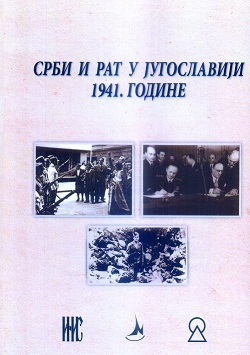Губици партизанског покрета са територије Србије у устанку 1941. године
The Losses of the Partisan Movement in the Territory of Serbia in the Uprising in 1941
Author(s): Dragan Cvetković
Subject(s): Civil Society, Social history, Demography and human biology, Victimology, WW II and following years (1940 - 1949), Peace and Conflict Studies
Published by: Institut za noviju istoriju Srbije
Keywords: Yugoslavia; Serbia; Occupied Serbia; war; losses; suffering; partisans; census; uprising; regions; national; gender; age and professional structure;
Summary/Abstract: The partly revised census “War Victims 1941–1945” from 1964 offers a possibility of analyzing the wartime losses of the population of Yugoslavia among which the killed members of the Partisan movement make up a considerable portion. Apart from general data about their losses it enables the insight into the make-up of the victims. Out of all partisans who had fallen in the uprising in Serbia, 88.53% originated from the territory of the occupied Serbia. The mass uprising in the occupied Serbia in 1941 caused large losses both among the insurgents and among civilians who died massively in reprisals. The partisan victims from the territory of the occupied Serbia make up 36.24% of partisan losses in Yugoslavia 1941, which is a large portion, since 27.95% of all Yugoslavia’s inhabitants lived in Serbia. The creation and defense of the liberated territory caused that 51.37% of the fallen partisans originated from Western and North-Western part of the occupied Serbia, although these regions were inhabited by 18.31% of the total population. Among other regions more affected were Central Serbia (14.43%) and the region of Belgrade (10.62%). One third of the partisan victims in the uprising (33.19%) lost their lives in November 1941. Quenching of the large-scale uprising in occupied Serbia caused the intensity of combats to decrease in this territory in 1942, so that the number of partisan victims also decreased 2.72 times. Among the partisans of Yugoslavia it made up 10.40% of total losses. Women made up 2.15% of the partisans who fell in the uprising. Most of them came from Western Serbia (35.09%) and Belgrade (24.56%). Almost one half of the victims (48.93%) were persons aged 15 to 24 whereas those older than 45 made up 3.53%. Although the largest part of the partisans who fell in the uprising were peasants (46.85%), in proportion to their share among the general population, the largest part of the partisan losses were made up of workers sympathizing with the revolutionary idea (22.64%), small businessmen (10.28%) and pupils and students (7.91%).
Book: Срби и рат у Југославији 1941. године
- Page Range: 437-458
- Page Count: 22
- Publication Year: 2014
- Language: Serbian
- Content File-PDF

